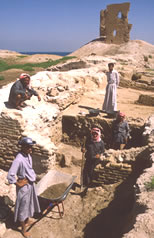Thomas Leisten, who joined the department in 1995 as professor of Islamic art and archaeology, is continuing the department’s long tradition of archaeology in the Levant. He is conducting excavations in central Syria at Balis, in the Euphrates Valley; a well-known site with remains dating from the Roman to the medieval period. His international team has included undergraduates from Princeton and Tübingen, as well as several Syrian archaeologists and conservators from England.
The focus of the excavations has been a large palace of the Umayyad period that was furnished with towers, gates, and luxurious living quarters with a marble-paved bath. Coins and inscriptions have dated this impressive structure, which measures about 200 feet on each side, to the late seventh or early eighth century A.D. The function of the building is also known:
 it belongs to the category of "desert
palaces" which served the Umayyad caliphs and their relatives as country
retreats, hunting lodges, and administrative centers throughout a wide area
that includes modern Syria, Jordan, Lebanon, and Palestine. Literary sources
suggest that the first owner of the palace at Balis was Maslama ibn Abdalmalik,
one of the most famous generals in the wars with Byzantium.
it belongs to the category of "desert
palaces" which served the Umayyad caliphs and their relatives as country
retreats, hunting lodges, and administrative centers throughout a wide area
that includes modern Syria, Jordan, Lebanon, and Palestine. Literary sources
suggest that the first owner of the palace at Balis was Maslama ibn Abdalmalik,
one of the most famous generals in the wars with Byzantium.Excavations in the summer of 2001 uncovered an entrance with well-preserved wall paintings depicting imitation marble veneer. Further excavations led to the discovery a large ceremonial audience hall, measuring about thirty by fifteen feet. Although this type of audience hall is common in Iran and Iraq in the later ninth century, it is highly unusual in an Umayyad palace. It is also the earliest Islamic example of this type of audience hall.
A field survey of the area surrounding the palace has located a good number of houses and other subsidiary structures that clustered around the palace, giving a glimpse of the community that flourished in area of the noble estate.
The Princeton team has also excavated in the area of the Byzantine city wall, clearing the area of the praetorium and uncovering a fairly complete Islamic building. This structure, whose walls still stand over fifteen feet high, yielded a collection of Islamic clothing, probably dating to the thirteenth century. A tantalizing inscription found in this building, which was entered only from outside the walls of the town, seems to include the names of Abbasid officials.
Global satellite positioning equipment has been used to map the locations of more than eighty tombs that lined both sides of the ancient road that led down to the Roman city Barbalissus, a major way station along the Euphrates which has now been submerged by Al Assad Lake. Six of the tombs have been excavated, revealing burial chambers decorated with reliefs depicting Heracles, Aphrodite, Jupiter Dolichenus, and other motifs typical of the pantheon of deities venerated in Roman north Syria.